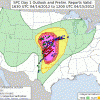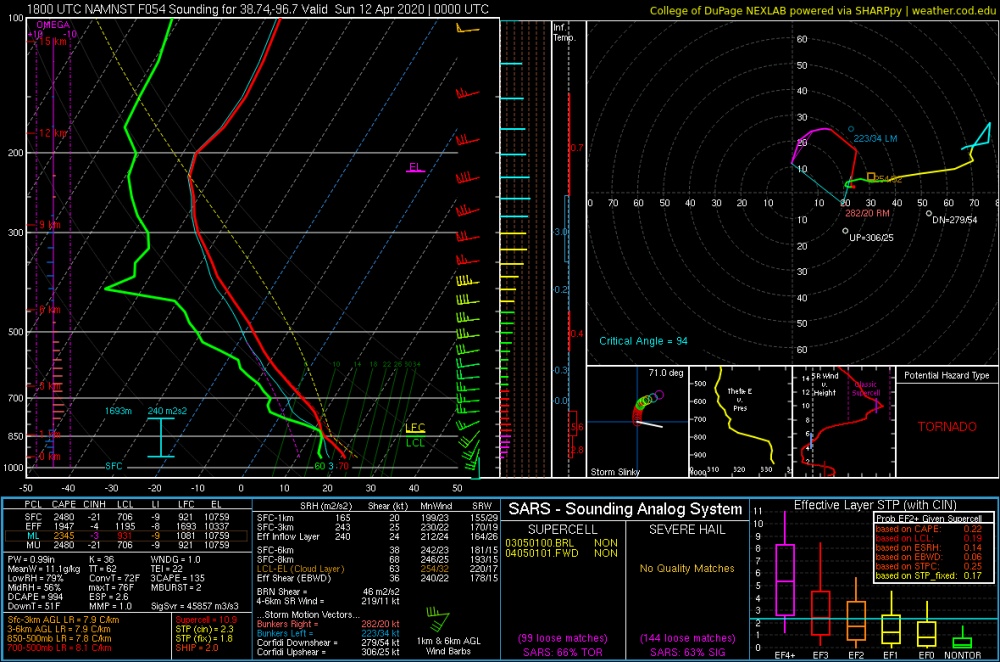-
Posts
4,228 -
Joined
-
Last visited
Content Type
Profiles
Blogs
Forums
American Weather
Media Demo
Store
Gallery
Everything posted by jojo762
-
Seems to show a lot of junkvection/blobs of precip especially across Mississippi through early afternoon. Which would seem to me to be a huge damper on any higher-end threat. NAM NEST shows significant recovery beyond that junk it’s showing, but I’m not sure I buy THAT much atmospheric recovery happening, especially that quickly.
-
00z NAM continued the slower, westward trend. Continues to depict a high-end environment across eastern Texas, all of Louisiana, southern/eastern Arkansas, all of Mississippi, southern Tennessee, and western Alabama. QPF/vertical velocity fields appear to show several rounds of supercells across the warm sector in a high-end parameter space. Appears to keep stuff cellular well into the night, much like the Euro, which is very concerning. Interested to see what the 00z hi-res CAMs will have to say given that 7pm Sunday will be the last frame of their runs; what they end up showing will likely determine if we see a 06z Day 2 High Risk or not.
-
Hard to get a much better signal in the QPF fields of a global model for supercells than this from the 12z Euro... Perhaps the more interesting part is that it maintains QPF streaks like those below WELL into the night.
-
Almost impossible not to imagine numerous discrete/semi-discrete supercells in the open warm sector on Sunday across Mississippi and Alabama with a 140-170kt 250mb jet core nosing in between 18-21z with 70 degree dewpoints at the surface.
-
After looking at various SHARPpy 12z NAM sounding locations across MS/AL from 18z to 00z on Sunday, i've made a few observations... 1. The wind profile has excellent turning with height from about 18-20z'ish across most of Mississppi and Alabama. 2. After 20z wind profiles progressively get uglier across much of the moderate-risk area; yes ESRH is still very impressive with values of 300-550m2/s2 prevalent across most of the threat area, but still the low/mid-level profile from about 2-7km starts to get a little less-than-ideal looking. 3. I think this could mean that potential warm sector supercells might start to get a bit grungy in the mid/later afternoon hours... Adding to wind profile issues, a lot of soundings are pretty darn saturated, so HP supercells could be pretty prevalent... It is probably too early to give a prediction but here is my two-cents based off of what I have seen... Altogether, I think early in the event several if not numerous supercells are going to be ongoing across Louisiana, Mississppi, and Arkansas... Some may produce long-tracking strong/violent tornadoes, and given the moist PBL some might be quite large... after a couple/few hours, storms might start to get clustery/HP looking and a tornado threat will persist, but it won't be anything like it was in the early afternoon... eventually we should end up with a large QLCS along the cold front, with severe-wind producing clusters of former supercells in Alabama or Georgia. The dry-slot could be a mitigating factor for clustery/HP modes in the later afternoon, but that remains to be seen.
-
Models have pretty much converged on a scary scenario for a large area... Encompassing perhaps parts or most of: Louisiana, Arkansas, Mississippi, Tennessee, Alabama, and perhaps Georgia. 00Z NAM, et. al, indicate that by as early as 18z on Sunday, the warm front will have lifted to the Tennessee border with a rather expansive, moist warm sector to its south. NAM is a tad more aggressive with instability than other models at this moment, but all models pretty much show a significant parameter space across a large area from 15z to 03Z (and beyond) on Sunday. General trend has been for less warm sector precip, as well... which is concerning.
-
SigTor of 90 at hour 72 is extraordinarily rare... wow.
-
Saturday does not look too bad across KS/OK (especially near the triple-point in Kansas)... Could be one of those sneaky days where nothing particularly stands out about the environment, but lapse rates are steep enough, and hodographs have a beautiful sickle shape, so a supercell or two might be able to go off for an hour or two.
-
Also, from a practical standpoint they just do not make sense. Too many things can happen between D3 to D1 to be sounding the alarms that much.
-
The "precipitation ahead of the main line" you're referencing would almost certainly be the main show, with several tornadic supercells in the open warm-sector associated with a pre-frontal trough -- consistent with outbreaks in Dixie Alley. Also, looks like the 12z GFS has mostly came on board with the rest of the models with respect to potential for a dangerous severe weather outbreak, still some important differences though, especially with instability in the warm sector. Not that it exactly matters, but would anticipate a rare Day 3 MDT risk encompassing large parts of Louisiana, Mississippi, and Alabama tomorrow. My knowledge of southeast tornado environments is fairly lackluster, but something of concern to me is a similar looking thermodynamic environment to 5/20/19 in Oklahoma, and storms really struggled that day to get going in spite of amazing shear... Perhaps someone more knowledgeable could chime in?
-
Hmmm... Euro seemingly shows this, when looking at morning/early afternoon QPF; but vectors and storm motions seem to indicate that any junky early stuff *could* lift north of the warm front, negating any deleterious impact to the warm sector. I definitely agree with the potential problem of how far north the warm front can retreat, especially with a possible morning MCS and/or plenty of elevated convection. Taking the Euro verbatim -- that would be a historic outbreak. Parameters aside, synoptic-scale (what's important at Day 6) specs on the euro are currently better than most outbreaks in that region. Doubt that it holds serve as is, especially given that this wave basically didn't exist a few runs ago, but we'll see.
-
Euro almost always wins in these situations, as the GFS is usually too fast with systems east of the Rockies... that being said, that doesn’t mean that the exact conditions the euro currently shows are going to come to fruition. It’s still in the “model lala land” range.
-
I know its not within the forum region, but the Southeast sub is boring. 12Z Euro is insane for Sunday in AL/MS. 100-110kt 500mb jet streak atop a 60-70kt LLJ, juxtaposed to 67-71 degree dewpoints and steep lapse rates leading to CAPE values on the order of 2000-4000 j/kg @ 21Z. Insane. 12Z GFS is about 9 to 12 hours faster than the ECMWF (go figure)
-
12Z Euro continues to depict potential for a high-end severe weather event on Sunday April 12 across mostly Mississippi, Alabama, and Tennessee. 100-110kt 500mb jet streak atop a 60-70kt LLJ, juxtaposed to 67-71 degree dewpoints and steep lapse rates leading to CAPE values on the order of 2000-4000 j/kg. Insane. 12Z GFS is about 9 to 12 hours faster than the ECMWF, leading to a significantly lessened severe threat. If the last few runs of the Euro were to verify, we would be dealing with a historic tornado outbreak, if the GFS verifies we will probably be dealing with a lower-end severe threat.
-

Central/Western Medium-Long Range Discussion
jojo762 replied to andyhb's topic in Central/Western States
I am pretty optimistic about late-April though. Not like that is anything surprising, but still... CFS loves late April/early May, severe wx dashboard is lighting up like a Christmas tree for that time frame. -

Central/Western Medium-Long Range Discussion
jojo762 replied to andyhb's topic in Central/Western States
Looks like the "early next week" trough (cut-off low) got pushed back by about four to five days, even so it is more likely than not that either the trough de-amplifies significantly INVOF the four corners, OR dives south into Mexico, so as far as a central/southern plains threat is considered, this is toast; Dixie Alley is a different matter however. Compounding this, a cold-front crashes across the central and southern plains on Wednesday evening and into Thursday, muting any potential threat regardless of the mid/upper level pattern. So that is a swing and a miss for some early April action. To make matters worse, the pattern becomes... really boring on the global models into at least mid-April. Should be noted, however, that substantial differences exist with respect to the mid/upper level pattern between the 12Z Euro and GFS by day 8+. GFS shows a ridge off the coast of California while the Euro shows a substantial trough approaching the southwestern CONUS. -

Central/Western Medium-Long Range Discussion
jojo762 replied to andyhb's topic in Central/Western States
Nobody has posted in here in quite awhile, so guess i'll try and kick start some 2020 severe season discussion. Looks like a fairly boring pattern will exist until at least early next week, Operational models and Ensembles have been persistent on showing a western trough ejecting into the plains at some point early next week, so that will be something to pay attention to. As of right now moisture return is seasonably impressive on most models -- but timing is an issue in model land-- this will change to some degree given that it is about a week-plus out. Beyond that, it look's like we'll have another few-day period of quiescent weather... Followed by what *could be* an interesting period in mid-April. Stay tuned. -
The scope of these large systems is really ridiculous sometimes... precipitation being produced in varying degrees from far northern Wisconsin, to near Houston (1100 to 1200 total miles as the crow flies).
-
Inflow is really ripping in both those storms.
-
The shot of those vehicles before ten seconds and the shot of the tree at ten seconds say all you need to know about this tornado...
-
Given the evolution of the storms in W IL, going to imagine lapse rates never really recovered — providing limited instability. Plenty of amazing shear throughout the column, maybe just too much given the assumed thermodynamic profile.
-
Numerous tornado warnings in progress. A pair of discrete supercells in W IL, things getting going — took longer than we all anticipated, but things are happening...
-
Cells east of DVN are really starting to look good. One of them just went TOR warned.
-
That'll probably change in the next couple hours. Better forcing is still lagging the dryline/PCF, evident by the CU field across E KS.
-
KDVN VWP currently exhibits 84kt 0-6km shear coupled with ~400m^2/s^2 0-1KM SRH... Assuming the wind profile is similar in SE IA south of the warm front, the atmosphere is absolutely primed for discrete supercells capable of producing numerous significant tornadoes. EDIT: 90/80 probs on that PDS watch.




